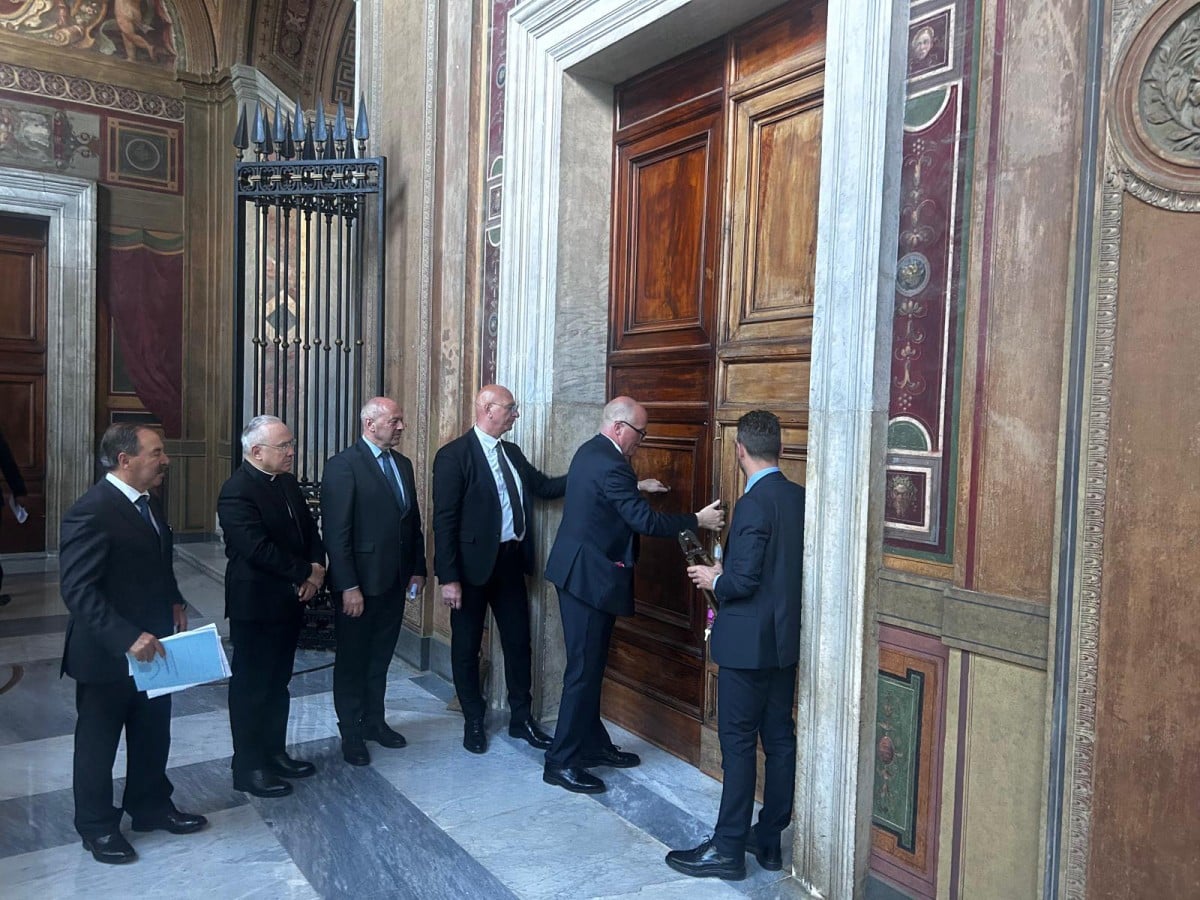Divided Church, divided vote: Why conclave may take longer than expected

This photo taken and handout on May 6, 2025 by The Vatican Media shows a Commission, chaired by the Substitute for General Affairs of the Secretariat of State, H.E. Mons. Edgar Peña Parra – and composed among others of the Commander of the Pontifical Swiss Guard, Col. Christoph Graf, and the Deputy Commander of the Gendarmerie Corps of the Vatican City State, Dr. Davide Giulietti, and members of the Directorate of Technical Services of the Governorate of the Vatican City State as the entrances to the Apostolic Palace are being closed ahead of the conclave to elect the next pope, in The Vatican. (Photo by Handout / VATICAN MEDIA / AFP)
MANILA, Philippines — When the doors of the Sistine Chapel are locked for the papal conclave today (May 7, 2025), the cardinal electors will step into perhaps the most polarized and contested election in modern Church history.
Unlike the relatively swift conclaves that elected Benedict XVI in just four ballots over three days in 2005, and Francis in five ballots over two days in 2013, the 2025 conclave promises to be a much longer and harder road to consensus.
Why? The answer lies in the deep divisions that have festered over the past 12 years of Pope Francis’ groundbreaking and, to many, unsettling papacy. His emphasis on inclusion, social justice, and a more pastoral approach to doctrine has drawn both admiration and fierce resistance.
READ: Cardinals end pre-conclave talks unsure who should succeed Francis
While he has opened doors to LGBTQ+ Catholics and highlighted the plight of migrants and the marginalized, his reforms have challenged entrenched traditions — alienating conservatives, traditionalists, and even some moderate cardinals wary of the rapid pace of change.
The divisions are not merely theoretical. Across the global Church, bishops and cardinals have quietly — and at times publicly — lined up along familiar but now hardening fault lines: progressive versus conservative, modernist versus traditionalist, center-left versus center-right.
In the U.S., for example, tensions flared when American bishops considered excommunicating pro-abortion politicians — a move the Vatican discouraged. In Africa, bishops outright rejected implementing Fiducia Supplicans, the controversial Vatican declaration allowing non-liturgical blessings of same-sex couples. Francis himself, sensing the storm, exempted African dioceses.
READ: What goes on at the conclave and how next pope is elected
As these camps head into conclave, they carry with them not just theological preferences but competing visions for the Church’s future. On one side are the progressives, like Cardinals Matteo Zuppi and Reinhard Marx, who favor continued reforms, openness to LGBTQ+ Catholics, and a Church more engaged with contemporary global issues.
On the other side stand figures like Cardinals Péter Erdő and Fridolin Ambongo, who champion a return to doctrinal clarity, liturgical tradition, and resistance to what they see as dangerous innovations.
Complicating the picture is the growing influence of the Global South. With more cardinals now coming from Africa, Asia, and Latin America, the traditional Eurocentric dominance in papal elections is waning. While some Global South prelates align with Francis’ progressive agenda, others, particularly from Africa, lean conservative, especially on issues like sexuality and liturgy.
This ideological gridlock makes it highly unlikely that any single candidate will easily secure the two-thirds vote needed to become pope in the early rounds of balloting. If no consensus emerges after repeated ballots, Church law — specifically Pope Benedict XVI’s 2013 Normas Nonnullas — dictates that only the two top candidates from the previous round can be considered, though they are barred from voting for themselves. Even then, the two-thirds threshold remains.
Such a deadlock could stretch the conclave beyond the brisk two- and three-day elections seen in 2005 and 2013. Days, perhaps even a week or more, of intense voting, prayer, and negotiation may be necessary before the cardinals can coalesce around a compromise candidate — someone who can bridge the chasm between left and right, tradition and reform, global north and south.
The conclave of 2025 will not simply be a vote for the next pope. It will be a referendum on the Francis era itself, a battle over whether the Church will continue along his path of reform or retreat to more familiar doctrinal ground. In this sense, the extended ballotings that seem almost inevitable are not a sign of dysfunction, but a reflection of a Church wrestling with its identity in a rapidly changing world.
When the white smoke finally rises over the Vatican, it will mark not just the end of a conclave, but the conclusion of a struggle that has been brewing for more than a decade — a struggle that could very well define Catholicism’s course for generations to come. /dl
Lito B. Zulueta, professor of journalism at the UST Faculty of Arts & Letters, covered the conclave of 2005 that elected Pope Benedict XVI and that of 2013 that elected Pope Francis.


















